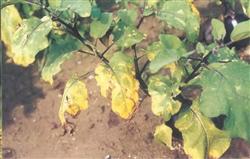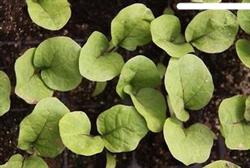Measures for preventing Verticillium Wilt of eggplant without grafting

Verticillium wilt is a common disease of eggplant. Grafting is an effective measure to control the disease. However, some vegetable farmers have planted eggplant seedlings without grafting now. How to control Verticillium wilt? The occurrence symptom of this disease and do not graft control measure introduce to everybody now. The disease mainly damages leaves, and can occur in all growth stages, with the most serious incidence in the fruiting period. Generally, the disease starts from the middle and lower leaves. At the initial stage of the disease, the lower or one part of the leaves wilted at noon, suspected dehydration wilting, recovered in the morning and evening, and no longer recovered after several days. Leaf color changed from yellow to brown, leaf margin curled upward, gradually extended upward until the whole plant was infected. Root, main stem, lateral branches and petioles were cut open, vascular bundles could be seen. Compared with healthy plants, susceptible plants turned yellow brown or brown. Then wilting parts or leaves continue to expand and increase, gradually throughout the whole plant, causing the whole plant wilting and dying. Verticillium dahliae invades root hair cells from wound and root system, enters vascular bundle and develops and reproduces in vascular bundle, flows to stem, branch, leaf, fruit and seed with plant body fluid, forming systematic infection. From seedling stage to growth stage can be infected. It overwinters with resting mycelium, chlamydospore and sclerotia and can survive 6~8 years in soil. The suitable temperature for the disease was 19℃~24℃, and the disease severity was low lying, improper watering, continuous cropping, continuous cropping and application of undecomposed fertilizer. Temperature 15℃~25℃, soil moisture or excessive watering times, high incidence. Especially in continuous cropping land, low-lying land, frequent cold air attack, lack of fertilizer or partial application of nitrogen fertilizer and application of undecomposed fertilizer, eggplant growth and development are poor, disease resistance is weak, which is conducive to the occurrence and spread of diseases. 2. Control measures 1. Select resistant varieties. Generally, the varieties with early maturity and low temperature tolerance have strong resistance to verticillium wilt. For example, Nongda 601, Kuaixing, Ziyue, Qieza 2, Qieza 9, Langgao, Ruima and Andrei all had good resistance to verticillium wilt and fusarium wilt. 2. Bacillus subtilis was applied. When the seedlings grow to 3~4 true leaves, the seedlings are drenched with 500-fold solution of Bacillus subtilis WP. When planting, 1 part of Bacillus subtilis wettable powder is mixed with 50 parts of fine soil, and 50g is applied to each hole. In the period of eggplant staring, Bacillus subtilis WP 1000 times solution was used to irrigate roots, and each plant was irrigated with 250 ml. 3. Potion cure. The roots were irrigated with 1000 times solution of 2.5% Schleswig suspension or 800 times solution of 75% Daconine WP or 600 times solution of 80% Daseng WP or 500 times solution of Thiophanate-methyl WP or 50% Carbendazim WP, and 250 ml of each plant was irrigated. It is suggested that vegetable farmers use green prescription and carry out prevention and control according to steps, so that eggplant will not be disturbed by diseases during its whole growth period. the early spring eggplant disease prevention and control scheme comprises the following steps: the first step: irrigating roots with 500 times solution of Bacillus subtilis wettable powder during transplanting, 50ml/plant; the second step: spraying 75% Daconin wettable powder once after 15 days; the third step: spraying 1500 times solution of amisida suspension once after 10 days; the fourth step: spraying 1200 times solution of 50% Ruizhen dispersible granule once after 15 days; and the fifth step: After 14 days, spray 40% and Rui water dispersible granules once; sixth step: after 12 days, irrigate the roots with 800 times solution of Bacillus subtilis wettable powder; seventh step: spray 1500 times solution of amisida suspension once after 12 days.
- Prev

Management of pod bearing stage of beans
Management of pod bearing stage of beans
- Next

Measures to prevent eggplant from falling flowers and fruits in greenhouse
The technology of cold bed seedling raising and transplanting of hot pepper and eggplant in greenhouse is the main measure to increase early yield, early fruit, early market and high benefit. First, the shed construction chooses to avoid the wind and the sun, flat terrain, fertile soil, convenient drainage and irrigation, low groundwater level, close to water sources, and has not planted eggplant fruits and vegetables for many years.
Related
- Where is it suitable to grow horseradish in China? it is expected to see the middle altitude horseradish in Alishan.
- How to prevent tomato virus disease reasonably? (Control methods included)
- Many people like to plant towel gourd on the balcony. What are the main points of this method and management?
- What crops can chili peppers be mixed with?
- Fertilization techniques and matters needing attention in Tomato
- What are the grafting techniques for peach seedlings in spring?
- Harm and control methods of root swelling disease of Chinese cabbage
- What are the pests of sweet potatoes? How to prevent and cure it?
- Symptoms, causes and Control methods of navel Rot in Tomato
- The cause of "Cucumber rotten bibcock" in Farmers' planting Cucumber and its Control Plan

